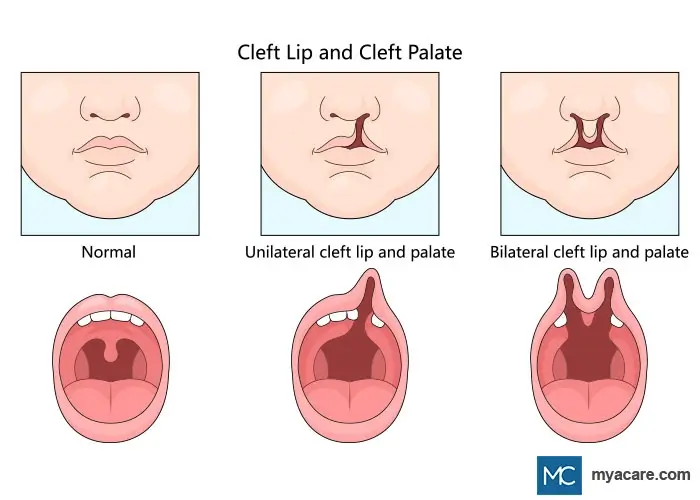Cleft Lip and Palate: Symptoms, Causes, Treatment and More

Medically Reviewed by Dr. Shilpy Bhandari
Cleft lip and palate are birth defects that affect the development of the upper lip and roof of the mouth (palate) respectively, resulting in a visible separation in these areas. During the first trimester of pregnancy, the lips and palate form when the tissues of the face come together and fuse. Any disruption in this process can result in a cleft lip and/or palate. These conditions can occur together or individually in the baby.
These conditions can significantly impact a child's physical and emotional well-being and ability to eat, speak, and breathe properly. Cleft lip and palate are a component of more than 200 different congenital disorders, such as DiGeorge syndrome, Treacher-Collins syndrome, Nager’s syndrome, and fetal alcohol syndrome.[1]
Cleft lip and palate are two of the most frequently occurring congenital defects, affecting around 1 in 700 newborns in the United States. The global prevalence of cleft lip and palate ranges between 6.64 per 10,000 births worldwide (3.28 per 10,000 for cleft palate alone). The prevalence varies by race and ethnicity, with Native American and Asian populations having the highest rates. They are more common in boys than in girls, with a distribution of 2 to 1.
This article will explore the types and symptoms, causes, available treatment options for cleft lip and palate, and the latest advancements in managing these conditions.
What is a Cleft Lip?
A cleft lip is a split opening in the upper lip that occurs in the 4th to 7th week of pregnancy. It can occur on one or both sides of the lip, ranging from a small gap in the skin to a large opening that extends into the nose, lending itself to nose deformity.[2]
What is a Cleft Palate?
A cleft palate is a large division in the roof of the mouth that develops between the 6th to 9th weeks of pregnancy. The palate is divided into the hard palate (the ridge near the teeth) and the soft palate (the remaining portion of the mouth roof).[3] The cleft can occur on one or both sides of the palate and range from a small opening to a large split extending into the nose.

Symptoms
Babies with cleft lip and palate may have difficulty feeding due to the opening in the lip or palate. This can make it challenging for them to create suction while breastfeeding or using a bottle. In addition, these conditions can also affect a child's speaking ability. The opening in the roof of the mouth can lead to difficulty producing certain sounds, and the child may also have trouble with resonance and volume.
Other common symptoms of a cleft lip and palate include:
- Difficulty breathing through the nose
- Speech issues
- Dental problems
- Ear infections (more common in cleft palate)
- Hearing loss
- Nasal and sinus issues
- Speech and language delays
- Psychological and emotional challenges
There are also many other congenital syndromes which cleft lip and palate form a part of which can give rise to other related symptoms, including heart defects, stunted growth, and intellectual disabilities.
Conditions Associated with Cleft Lip and Palate
One of the most common birth defects associated with cleft lip and palate is CHARGE syndrome, which is an acronym for:
- Coloboma (an aperture or hole in any parts of the eye, such as the iris, retina, or optic nerve)
- Heart defects
- Atresia choanae (blockage or closure of the back of the nasal passages)
- Growth retardation (delays or restrictions in physical growth and development)
- Genital abnormalities (reproductive irregularities)
- Ear abnormalities
Children with cleft lip and palate may also have other associated conditions, such as:
- Treacher Collins syndrome, a genetic disorder characterized by facial deformities, specifically affecting the development of the cheekbones and jaw.
- Nager's syndrome, a rare genetic condition that primarily affects the development of the face, hands, and arms.
- DiGeorge syndrome, a chromosomal disorder that leads to a range of developmental and health issues, including heart defects and immune system abnormalities.
- Fetal alcohol syndrome, a condition caused by prenatal exposure to alcohol, leads to physical, cognitive, and behavioral challenges in children.
- Waardenburg syndrome, a genetic condition characterized by hearing loss and pigmentation abnormalities of the hair, skin, and eyes.
- Pierre Robin syndrome, a congenital condition that involves a small lower jaw, cleft palate, and a tendency for the tongue to fall back in the throat, leading to breathing difficulties.
- Down syndrome, a genetic disorder arising from an extra copy of chromosome 21, leading to developmental delays, intellectual disabilities, and characteristic facial features.
What Causes a Cleft Lip and Palate?
The precise cause of a cleft lip or palate is not fully understood. It is thought to be a complex interplay between genes and environmental influences impacting the fetus's development in the womb.[4]
Genetic mutations and congenital disorders account for up to 30%.
Risk Factors for Cleft Lip and Palate
While the exact cause of cleft lip and palate is unknown, certain risk factors may increase the likelihood of a baby being born with these conditions. These include:
- Family history of cleft lip or palate
- Maternal smoking or alcohol use during pregnancy
- Gestational diabetes
- Exposure to certain medicines or toxins during pregnancy, including dioxin, phenytoin, valproic acid, retinoic acid, and thalidomide
- Nutritional deficiencies during pregnancy
- Prenatal viral illness
- Advanced maternal age
- Consanguineous marriage (Marriage between closely related relatives)
- Boys are more likely to have cleft lip, but girls are more likely to have cleft palate
How to Prevent Cleft Lip and Palate During Pregnancy?
While there is no guaranteed way to prevent cleft lip and palate, expectant mothers can lower the risk by:
- Avoiding smoking and alcohol use during pregnancy
- Taking prenatal vitamins, such as folate, and eating a healthy diet
- Avoiding exposure to toxins and medications that are known to increase the risk of birth defects
- Seeking genetic counseling if there is a family history of cleft lip or palate
How is Cleft Lip and Palate Diagnosed?
Cleft lip and palate is often diagnosable during routine prenatal ultrasounds after the first trimester. Further testing may be recommended if a cleft lip or palate is suspected, such as a fetal MRI or amniocentesis.
After birth, a physical examination can confirm the diagnosis of the cleft lip and palate. Additional tests can assess the severity of the condition and determine the best course of treatment.
Early diagnosis allows for proper planning and preparation for the baby's care after birth, as well as the opportunity for parents to connect with support groups and other families with similar experiences.
Cleft Lip and Palate Treatment and Management
The standard treatment of a child with cleft lip and palate is surgery.
The child will often require a multidisciplinary team of specialists to help oversee and manage their condition, including:
- Ear, nose, and throat (ENT) specialist
- Oral-facial surgeon, dentist or orthodontist
- Speech therapist
- Audiologist
- Psychologist
- Genetic counselor
- Social worker
This team will create a detailed treatment plan that takes into account the child's emotional, psychological, and physical requirements.
Surgical Repair
Surgical repair is the most common treatment for cleft lip and palate. The timing and order of surgeries will depend on the seriousness of the condition and the child's overall health.
The surgeries used to treat cleft lip and palate can vary depending on the severity of the condition. Here are the commonly performed procedures[5]:
- Cleft Lip Repair: Cleft lip repair is typically performed when the child is between 3 and 6 months old. The surgery entails creating incisions on either side of the aperture, carefully bringing the tissues together, and closing the gap. This procedure improves the appearance and function of the upper lip.
- Cleft Palate Repair: When the child is between 9 and 18 months old, cleft palate repair is typically performed. The surgeon will make incisions on both palate sides, reposition the muscles and tissues, and close the gap. This procedure aims to improve speech and feeding and prevent ear infections.
- Surgery for Ear Tubes: Ear tubes might be inserted in children with cleft palates to decrease the chances of chronic ear fluid accumulation, which can cause hearing impairment. In this surgical procedure, minuscule spool-shaped tubes are put into the eardrum to craft a passage that inhibits fluid accumulation.
An infant may need a feeding tube until they receive their first surgery.
Additional surgeries may be necessary as the child grows and develops into a teenager, including cosmetic surgeries, such as:
- Bone grafting, which uses bone from another part of the body to fill the gap in the upper jaw, primarily when the aperture affects the gum line.
- Pharyngoplasty involves reconstructing the back of the throat (pharynx) to improve speech and prevent the escape of air through the nose.
- Rhinoplasty (nose surgery) may be performed later in adolescence to correct any aesthetic or functional issues with the nose, as cleft lip and palate can impact the nose's structure and form.
Non-Invasive Techniques
Non-invasive methods may occasionally be able to enhance the lip and palate's appearance and functionality. These may include:
- Nasal molding is a technique used for infants with cleft lip and palate, where a special device is placed on the nose to gently reshape and mold the nasal cartilage, aiming to enhance the nose's symmetry and look prior to surgical repair[6].
- Lip taping is a technique where a small piece of tape is applied to the infant's upper lip to help bring the cleft edges closer together, promote tissue alignment, and facilitate optimal growth and development of the lip.[7]
- Palatal obturators are devices that fit into the roof of the mouth, filling the gap to help with feeding and speech for individuals with cleft palate.[8]
Psychological Well-being
Living with cleft lip and palate can significantly impact a child's psychological well-being. Parents and caregivers must provide emotional support and help their child develop a positive self-image.
Support groups and counseling can also benefit the child and their family.
Living with Cleft Lip and Palate
While cleft lip and palate can present challenges, children can live happy and fulfilling lives with proper treatment and support. Parents and caregivers must provide emotional support and help their child develop a positive self-image.
Regular follow-up appointments with the cleft team and ongoing speech therapy can help children manage ongoing issues and improve their speech and communication skills.
Breastfeeding Support for Babies with Cleft Lip and Palate
Breastfeeding can be challenging for babies with cleft lip and palate, but it is possible with the right support and resources. Some tips for breastfeeding a baby with cleft lip and palate include:
- Using a specialized bottle or nipple to help with feeding
- Using a lactation consultant for guidance and support
- Pumping and using a feeding tube if necessary
- Trying different positions for breastfeeding to find what works best for the baby
Latest Advancements
Advancements in technology and surgical techniques have vastly improved the outcomes for children with cleft lip and palate. Some of the latest advancements include:
- 3D printing for creating custom surgical guides and devices[9]
- Minimally invasive techniques for cleft palate repair
- Virtual surgical planning for more precise and efficient surgeries[10]
- Stem cell therapy for tissue regeneration and scar reduction[11]
Can cleft lip be cured in the womb?
While curing cleft lip and palate in the womb is not currently possible, researchers are exploring the possibility of in-utero cleft palate repair. Gene mutations governing the process of lip and palate fusion, such as Dkk1 and Dkk2, were targeted with gene silencing therapies in mice, successfully leading to fully formed lips and palates in all treated mice.[12]
Conclusion
Cleft lip and palate are common conditions occurring at birth that significantly impact a child's physical and emotional well-being. Detecting these conditions early and taking a multidisciplinary approach to treatment can improve outcomes for children. The latest technological advancements in surgical technique give children with cleft lip and palate hope for a happy and fulfilling life.
To search for the best ENT Providers worldwide, please use the Mya Care Search Engine.
To search for the best General Surgery Providers worldwide, please use the Mya Care Search Engine.
The Mya Care Editorial Team comprises medical doctors and qualified professionals with a background in healthcare, dedicated to delivering trustworthy, evidence-based health content.
Our team draws on authoritative sources, including systematic reviews published in top-tier medical journals, the latest academic and professional books by renowned experts, and official guidelines from authoritative global health organizations. This rigorous process ensures every article reflects current medical standards and is regularly updated to include the latest healthcare insights.

Dr. Shilpy Bhandari is an experienced dental surgeon, with specialization in periodontics and implantology. She received her graduate and postgraduate education from Rajiv Gandhi University of Health Sciences in India. Besides her private practice, she enjoys writing on medical topics. She is also interested in evidence-based academic writing and has published several articles in international journals.
Sources:
Featured Blogs



